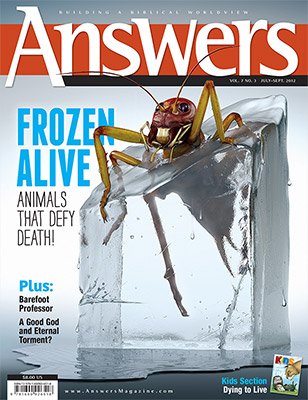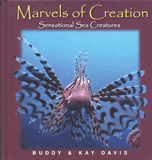Nudibranchs
Created Creature
The words “slug” and “festive display of color” don’t usually come to mind at the same time. But that’s exactly what happens when you dive into the world of sea slugs, known as nudibranchs. Their colorful variety is unmatched on the planet . . . as are their unique designs to fend off predators.
There are hordes of predators lurking in oceans around the world, leaving a trail of slime everywhere they hunt. They seemingly have no fears, even of the deadliest seafloor creatures. Instead of fleeing in terror from an adversary’s poison barbs, they calmly steal their prey’s defenses for their own armor, storing the toxins inside their own skin to frighten other enemies.
They come in all shapes and sizes—some are brightly colored, bold, and flashy, sporting colorful blue stripes or bright pink polka dots, while others stay hidden, camouflaged among their surroundings. They can be short or long, round or flat, bold or subtle, but these real-life monsters aren’t science fiction. In fact, the tiny nudibranch is one of God’s most common—and beautiful—creatures.
A type of sea slug, nudibranchs (NEW-de-branks) are gastropods, which means “stomach-foot.” There are more than sixty thousand named species of gastropods (snails and slugs), and they live everywhere, from land to sea, in almost every climate and habitat, crawling around on their “foot.” Nudibranchs are just one example of the adaptability of this huge class of animals. More than three thousand known species of nudibranchs inhabit oceans and saltwater seas worldwide, especially warm coastal waters.
What’s in a Name?
The name nudibranch means “naked gill.” While they don’t have gills like fish, nudibranchs do have exposed tentacle-like bulges on their backs through which they breathe. They have tiny eyes, embedded in the skin on their backs, that can discern light and dark, but they get around primarily by feel and smell. Two horns on their head, known as rhinophores, pick up chemical clues in the water around them, guiding them to food or other nudibranchs, or warning them about approaching predators. Sometimes a nudibranch will follow another sea slug’s slime trail or go the other way if the chemicals in the slime signal danger.
But why should a humble sea slug have been endowed with such a magnificent variety of color and beauty? Like the flowers of the field, which were more splendidly arrayed than King Solomon (Matthew 6:28–29), the nudibranch displays the glory and creativity of the Designer, whose love for beauty is evident in His creation. Flaunting bright colors and whimsical patterns, nudibranchs glide gracefully over the ocean floor, tentacles rippling in the current, a feast for the eyes, if not for the palate.
Nudibranchs are born with shells, like snails, but shed them as they grow into adulthood. It might seem foolish to give up their armor, but the nudibranch enjoys the best of both worlds—in their shell-less state their beauty is revealed for all to see, and they can deploy more sophisticated weapons. God has equipped them with some of the weirdest defense mechanisms on the planet.
Look, But Don’t Touch
Some nudibranchs blend into their surroundings using camouflage, while others sport bright, vivid colors that serve as a warning to would-be predators that this tasty treat might not be safe to eat. Although this kind of warning is common in nature (who hasn’t heard of poison dart frogs?), scientists have a difficult time explaining why conspicuous creatures are less likely to be preyed upon.
Perhaps the Creator placed in His creatures the instinct to back away from bright colors and then gave those bright colors to the creatures that would otherwise be vulnerable. These vivid colors are effective not only as a defense mechanism but also as a striking example of beauty in creation, providing visual delight for man, the one earthly creature designed to recognize God’s handiwork and worship Him for it.
While the vivid colors are sometimes a false alarm, for most nudibranchs the warning ought to be heeded. Some of them taste foul, and others are inherently poisonous, releasing an acid when touched or irritated. And as you will see, others have “stolen” defenses that are downright amazing.

© Olga Khoroshunova | Dreamstime.com; © Jonmilnes | Dreamstime.com; © Kkg1 | Dreamstime.com; © Derek Holzapfel | Dreamstime.com; © Carol Buchanan | Dreamstime.com; © Kkg1 | Dreamstime.com; © Olga Khoroshunova | Dreamstime.com; © semet | istockphoto.com; © danschmitt | istockphoto.com
These beautiful colors may appeal to humans, but they flash a warning to other sea creatures: "Don’t eat me!” Though highly poisonous, the red-gilled nudibranch wasn’t born deadly. It eats poisonous food and stores the poison in its skin to ward off predators!
You Are What You Eat
You’ve probably heard that you are what you eat (a good reminder to eat healthy food to have a healthy body), but the nudibranch takes this adage to extremes.
Nudibranchs are carnivores, preying on anemones, sponges, barnacles, other sea slugs (sometimes even their own species), and other dangerous or toxic prey that most sea creatures avoid. Then they become what they eat.
Some nudibranchs that feed on jellyfish or anemones, for example, will ingest the poisonous stingers, but instead of digesting them—and probably dying from the poison—they will pass the stingers through their gut to the surface of their skin, storing them in their tentacles, where they are useful for defense.
Evolutionists find the nudibranch difficult to explain. From an evolutionary perspective the creature doesn’t make sense.
Similarly, other nudibranchs will feed on poisonous sponges and store the poison in their bodies, ready to sicken anything that eats them. No one knows exactly how nudibranchs survive ingesting poison or stingers. Scientists believe they have specially protected cells with thick membranes, but how the process works is unclear.
Evolutionists find the nudibranch and its thieving ways difficult to explain. After all, from an evolutionary perspective the creature doesn’t make sense: its vivid colors are conspicuous to predators, it eats poisonous prey but doesn’t die, and it somehow borrows the defense mechanisms of the creature it just consumed. It is difficult to imagine how such a creature could have evolved by chance.
It makes much more sense to believe that the nudibranch was specially designed by God, who created these incredible creatures with the skills necessary to survive in a fallen world. Fascinating, beautiful, and quite often deadly, the nudibranch is one of the most striking examples of our Creator’s creativity and ingenuity.
Did You Know?
- Nudibranchs are not the only creatures referred to as “sea slugs.” Some of the other shell-less mollusks, such as the sap-sucking sea slugs (sacoglossans), are also brightly colored. But only the nudibranch breathes through “naked gills” on its back or rear.
- Nudibranchs can lay up to two million eggs at a time. They lay eggs in coils or spirals of jelly.
- Like their terrestrial cousins, nudibranchs leave slime trails.
- Nudibranchs can produce fruity or floral fragrances, which scientists believe act as a warning, much like their vivid colors.
- One species of nudibranch can feed on the surface of the water by holding air in its gut and floating.
- Nudibranchs can range in size from half an inch to twelve inches, and come in many shapes, from round to long to flat.
CLASS: Gastropoda
SUBCLASS: Orthogastropoda
SUPERORDER: Heterobranchia
ORDER: Opisthobranchia
SUBORDER: Nudibranchia
DIET: Nudibranchs are carnivores, feeding on sponges, anemones, coral, jellyfish, barnacles, eggs, small fish, other sea slugs, and
sometimes even their own species.
HABITAT: Nudibranchs inhabit all oceans and saltwater seas worldwide, especially warm, shallow areas.
Answers Magazine
July – September 2012
It’s impossible to explain how even one creature could evolve by chance, but in fact all life needs a complete community of other organisms to survive. The web of life had to be in place from the very start for any of us to exist. What an amazing testimony to the Creator! Also learn about animals that seem to come back from the dead, robotics, and how archaeology in Jordan confirms the Bible’s history.
Browse Issue SubscribeRecommended Resources

Answers in Genesis is an apologetics ministry, dedicated to helping Christians defend their faith and proclaim the good news of Jesus Christ.
- Customer Service 800.778.3390
- © 2024 Answers in Genesis






